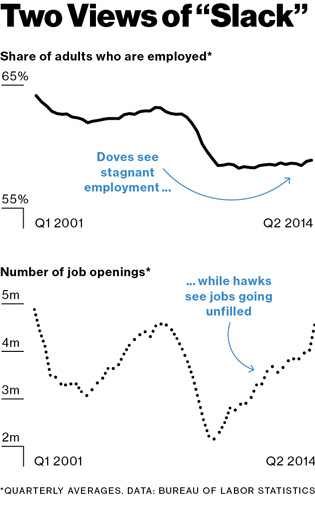How Much Surplus Labor Do We Have?
By Peter Coy and Matthew Philips
August 21, 2014 - Businessweek
Janet Yellen wants the hawks in the Federal Reserve System to cut her some
slack on the topic of slack. As economists use the term, slack in the job market
is a measure of labor supply. Too much slack means high unemployment. Too little
means worker shortages, spiking wages, and inflation. Whether therefs too much
slack, too little, or just the right amount has been a topic of intense debate
since well before Yellenfs scheduled Aug. 22 speech on labor markets at the
Federal Reserve Bank of Kansas Cityfs annual conference in Jackson Hole,
Wyo.
Yellen, in her first year as chair of the Fedfs board of governors, is a
slacker—she says the labor market remains soft and the central bank should keep
concentrating on growth, not restraining inflation. Shefs up against a group of
hawks such as Charles Plosser, president of the Federal Reserve Bank of
Philadelphia, who say the slack is all but used up. Both sides cite official
statistics to make their cases. gTherefs lots of asymmetry out there in the data
right now,h says Neil Dutta, head of U.S. economics at Renaissance Macro
Research.
Doves on the rate-setting Federal Open Market Committee (FOMC) play down the
falling unemployment rate (6.2 percent in July) because, as they point out,
it counts only people who are actively seeking work. The 2007-09 recession was
so deep that many people stopped looking. Employment as a share of the adult
population remains depressed. The dovish theory is that if demand heats up, many
of those people will be drawn back into the workforce.

Easy-money advocates point to the high number of people—7.5 million—who
want full-time jobs but are working part-time for economic reasons like
gunfavorable business conditions.h Before the recession began, there were only
4.6 million people in that situation. In a recent speech, Minneapolis Fed
President Narayana Kocherlakota cited involuntary part-timers as evidence that
plenty of workers are on the sidelines, ready to fill increased demand for
labor.
The Fed chair has managed to keep most of the FOMC on her side. After its
latest meeting on July 30, the committee said in a statement that ga range
of labor market indicators suggests that there remains significant
underutilization of labor resources.h All of the Fed governors in Washington
lean dovish, as do presidents of the regional banks in New York, Chicago,
Boston, and San Francisco, not to mention Kocherlakota.
But Yellen canft take support for granted. Philadelphiafs Plosser dissented
from the July 30 statement on the grounds that the language about how long
interest rates will be kept low gdoes not reflect the considerable economic
progress that has been made toward the Committeefs goals.h Minutes released on
Aug. 20 revealed some sympathy for that view among other FOMC members.
Besides Plosser, the hawks include the Fed presidents in Richmond, St. Louis,
and Dallas. (Not all regional presidents vote in any given year, though all
participate in FOMC deliberations.) Hawks focus on the sharp increase in the
number of unfilled jobs, asking how much slack there could truly be in the labor
market if there were 4.7 million openings for workers at the end of June.
Thatfs up from a low of 2.1 million in July 2009. They are concerned that
many people who dropped out of the labor market are never coming back—because
they retired early or went on disability, or their skills atrophied. Declining
unemployment could soon switch from a good thing to a bad thing, they suggest.
In a recent speech, Dallas Fed President Richard Fisher said, gThe economy is
reaching our desired destination faster than we imagined.h
To Yellenfs credit, an inflationary spike in wages is nowhere in sight. Given
current inflation and productivity growth, workers should see wage gains above
3 percent, says Ethan Harris, co-head of global economics research at Bank of America Merrill Lynch
(BAC). Wage growth has been closer to
2 percent, no higher than overall inflation. Itfs possible, as the hawks
worry, that wage pressure is building up unnoticed. But Yellen has said that a
little bit of above-target wage growth is OK as long as the public continues to
believe that inflation will remain low over the long term. For now, the slackers
at the Fed are running the show.